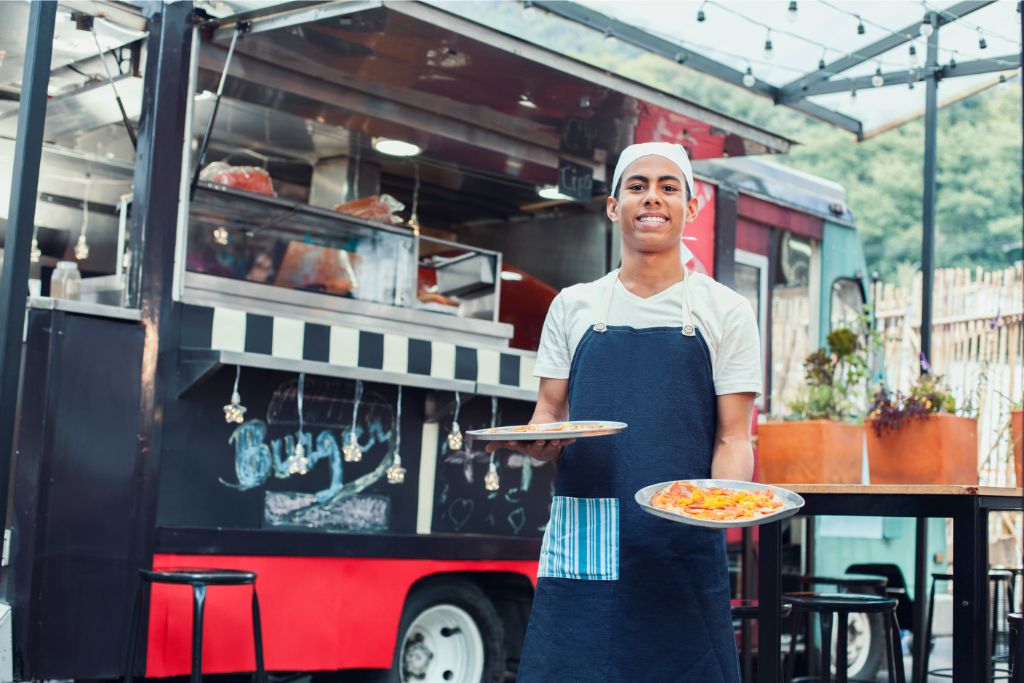Social Media Strategies To Boost Your Food Truck Business

Hey, you’ve got a food truck. Are you struggling with social media? No worries, we’re here to help! The right strategies will boost your business.
Want to understand your audience? Collaborate with influencers? Here’s how you can use social media for your food truck.
Ready to attract more customers? Let’s go!
Table of Contents
- 1 Understand Your Target Audience
- 2 Select the Right Social Media Platforms
- 3 Develop a Consistent Brand Voice
- 4 Engage with Your Audience
- 5 Post Regularly and at the Right Times
- 6 Use High-Quality Visuals
- 7 Collaborate with Local Bloggers and Influencers
- 8 Track Your Performance and Adjust Your Strategy
- 9 BONUS
- 10 Frequently Asked Questions
- 10.1 What cost-effective ways do I advertise my food truck business on social media?
- 10.2 How can I leverage user-generated content to promote my food truck business on social media?
- 10.3 Are specific social media platforms particularly effective for food truck businesses?
- 10.4 How can I encourage my followers to share my posts and increase my social media presence?
- 10.5 What are some common mistakes food truck businesses make when using social media for marketing, and how can I avoid them?
Understand Your Target Audience

You must understand your target audience if you want your food truck business to thrive on social media. It’s not just about posting mouth-watering images of your best dishes; it’s about knowing the audience’s demographics and consumer preferences.
Ask yourself, who typically visits your truck? Are millennials seeking a quick bite between work meetings? Families looking for an unconventional dining experience at the weekend? Foodies eager to taste the latest culinary trends?
Once you’ve identified these demographic groups, dive deeper into their likes, dislikes, and habits. What time do they usually eat? Which social media platforms do they frequent most often – Instagram, Facebook, or Twitter? Do they prefer posts with lots of visuals, or are they more interested in reading short stories behind each dish?
Remember that understanding consumer preferences extends to what type of content resonates with them. If your customers love seeing the preparation process, consider sharing behind-the-scenes videos on Instagram Stories or TikTok.
Select the Right Social Media Platforms
Choosing the best online platforms for promoting your mobile eatery is crucial to reaching a wider audience. Platform selection should be based on social media trends, your target demographic’s preferences, and what fits with your brand image.
Consider these four key elements when making your decision:
- Demographics: Different platforms attract different age groups. Instagram and Snapchat are popular with younger audiences, while Facebook tends to draw an older crowd.
- Engagement: Platforms like Instagram allow for high visual engagement, perfect for showcasing your food truck’s culinary delights.
- Frequency of Use: Twitter users often check their feeds multiple times per day, providing opportunities for real-time updates about your location or daily specials.
- Local Influence: Local-based platforms like Yelp can boost visibility in specific geographical areas.
Remember, it’s not about being everywhere at once but focusing on where you’ll make the most impact. Keep up-to-date with social media trends so you’re always ahead of the game! Make sure to evaluate each platform’s success regularly; if one isn’t giving you results, don’t hesitate to try another strategy or platform until you find what works best for your business.
Develop a Consistent Brand Voice
Developing a uniform brand voice that’ll resonate with your audience and make your mobile eatery stand out is essential. Brand voice consistency is crucial in the food truck industry, which thrives on its unique, often quirky persona. Your voice should reflect your brand’s personality – whether fun, sophisticated, or adventurous.
Think about what makes your food truck unique. Is it the gourmet burgers you serve? The locally sourced ingredients? Or perhaps the friendly service? Let these aspects shine through in your social media posts. But remember, while maintaining consistency, don’t be afraid of voice evolution as trends shift and your business grows.
Keep an eye on food industry trends to keep your content relevant and engaging. Use those trending hashtags wisely! Don’t neglect visual content either – tantalizing pictures of today’s specials can drive footfall like nothing else!
Engage with followers consistently using this unique tone of voice – respond to comments and messages timely; this will strengthen customer relationships and boost loyalty.
So carve out a distinct brand voice for your food truck business on social media platforms to build connections with patrons and set you apart from competitors!
Engage with Your Audience
In the fast-paced world of food trucks, keeping your finger on the pulse of customer engagement is crucial. You must respond swiftly and thoughtfully to comments and messages, embracing them as invaluable opportunities to build relationships with your patrons.
Running contests and promotions is also a fantastic way to stir up excitement around your brand, rewarding loyal customers while reeling in fresh faces.
Respond to Comments and Messages
Don’t underestimate the power of responding to comments and messages. It can significantly enhance your food truck business’s social media presence. It’s not just about posting savory pics or sharing mouth-watering menus – engagement is crucial.
Handling negative feedback may seem daunting, but it’s an opportunity to show off your excellent customer service skills. Respond promptly and professionally, turning a potentially damaging situation into a showcase for your commitment to satisfaction.
Utilizing auto-replies can be invaluable, too. These instant responses assure customers their voices are heard, even when you’re busy flipping burgers or catering events. However, don’t over-rely on them; personalized responses carry more weight.
Stay up-to-date with food industry trends and leverage these insights in your interactions to create a dynamic and impactful social media presence.
Run Contests and Promotions
After effectively responding to your followers’ comments and messages, you can keep the engagement rolling by transitioning into contests and promotions. This is where prize selection tips and contest mechanics planning come in handy.
Now, let’s talk about how to run a successful promotion.
Choosing suitable prizes for social media contests can significantly boost your food truck business. You’re aiming for something that aligns with your brand but also stirs excitement among your followers – perhaps a month of free meals or an exclusive cooking class?
When it comes to contest mechanics planning, simplicity is vital. Complex rules may deter participation. A standard format asks followers to like, share, or comment on a post – straightforward yet effective in increasing visibility and customer engagement.
Post Regularly and at the Right Times
Your audience engagement will significantly increase if you stick to a consistent posting schedule and choose optimal times. Peak Engagement Hours are crucial in the food truck industry, as they often coincide with meal times when customers are most likely seeking out their next tasty treat. Utilize Scheduling Tools to ensure regular posts during these hours, ensuring constant visibility.
Here’s what you need to consider:
- Identify your peak times: Usually, breakfast, lunch, and dinner hours align with high social media activity. Observe your audience’s behavior or use analytics on platforms like Instagram or Facebook.
- Use scheduling tools: Apps like Hootsuite, Buffer, or Later can help automate this process.
- Consistent Posting: Ensure you’re active across all platforms regularly. It’s not enough to post only when you have time.
- Engage in real-time: While scheduled posts maintain consistency, real-time interaction adds a personal touch essential for customer retention.
Use High-Quality Visuals
High-quality visuals are a must-have in your online posts as they’ll initially grab people’s attention. Visual content creation is critical to engaging potential customers. Show them mouth-watering images of your food, behind-the-scenes looks at how it’s made, and happy patrons enjoying their meals.
Image optimization techniques can further enhance the impact of your photos. Optimize for mobile devices where most social media browsing occurs, use filters judiciously to highlight the delicious qualities of your dishes, and always ensure good lighting.
Here’s a handy table showing some effective visual content creation strategies:
| Strategy | Why It Works | |
|---|---|---|
| 1 | High-resolution images | Crisp details make food look more appealing |
| 2 | Filters for emphasis | Heightens colors and contrasts |
| 3 | Behind-the-scenes shots | Foster’s connection with the audience |
| 4 | Customer spotlights | Encourages others to share their experiences |
| 5 | Consistent branding | Helps solidify identity |
Visuals aren’t just about pretty pictures; they’re a powerful tool in conveying your food truck’s brand story. Remember, you’re not just selling food; you’re selling an experience that starts with eye-catching visuals.
Collaborate with Local Bloggers and Influencers
Now that you’ve nailed the art of showcasing your delicious dishes with high-quality visuals let’s shift gears and talk about an equally compelling strategy – partnering with local influencers and bloggers.
Influencer partnerships and blogger outreach are potent tools in the food truck industry. In today’s digital era, social media influencers and food bloggers substantially impact where their followers dine. Partnering with them can provide your food truck business a significant boost.
They can create authentic content featuring your mouth-watering meals, highlight unique aspects of your food truck, or even host giveaways to drive their audience to your business.
Here’s how you can effectively use influencer partnerships and blogger outreach to boost your food truck business:
- Identify local influencers and bloggers who have a strong following in your city or region.
- Reach out to them for potential collaborations—this could be a sponsored post, review, or giveaway.
- Offer exclusive discounts or freebies in exchange for their feature/review.
- Make sure they tag your social media profiles when posting about you.
- Monitor the response from these promotions—track any increase in followership, engagement rates on posts related to the collaboration, or footfall at your truck.
Track Your Performance and Adjust Your Strategy
Staying ahead of trends and engaging your audience is critical in the fast-paced food truck industry. You’ll need to harness the power of social media analytics to understand what’s resonating with your customers and what isn’t.
It’s crucial not just to set a strategy but also to review and update it regularly. This will help keep your brand fresh, relevant, and top-of-mind for hungry patrons scrolling through their feeds.
Use Social Media Analytics
You’ll need to regularly monitor your social media analytics to understand what’s working and isn’t in your food truck business promotion. It’s not just about tracking likes or shares but analyzing competitors, too. Get a grip on their strategies, see what they’re doing right, and learn from it. Are they leveraging trends effectively? If so, take a leaf out of their book.
In this fast-paced food industry, you’ve got to stay updated with the latest culinary fads- vegan dishes or exotic cuisines, maybe? Tailor your posts accordingly, tap into these trends, and watch the engagement soar. Remember, social media isn’t static; it evolves with users’ tastes and preferences. So keep an eye on those metrics, and don’t hesitate to tweak your strategy as needed.
Your food truck business will thank you for it.
Regularly Review and Update Your Strategy
Regular revisions and updates to your plans can’t be overlooked if you aim for continued growth and success. In the ever-evolving food industry, staying abreast of trends is crucial. Strategy evaluation plays a significant role in this process. It assesses how well your social media strategies align with your food truck business goals.
To keep ahead of the game, competitor analysis is a must-do task. You’ve got to know what other food trucks do on social media platforms and identify opportunities to outshine them. Whether tweaking your hashtags or changing your visual content strategy, always be ready to adapt.
BONUS
Boost your food truck business with OnlySocial’s essential Post Planning and Scheduling function. Seamlessly plan and schedule your posts across all social networks, ensuring consistent and strategic content delivery. With unlimited posting and the ability to manage unlimited social profiles, you can expand your online presence without limitations. Don’t miss out on optimizing your social media strategy. Sign up for a commitment-free 7-day trial today.
Frequently Asked Questions
Harness the power of targeted ads on social media giants like Instagram and Facebook. Aim these specifically at local food lovers. How about partnering with influencers? It’s an affordable method to tap into their follower base. Trust me; their fans heed their advice!
Ask your fans to share snaps with your food truck using a unique hashtag. Why not kick off a competition for the top picture? Also, team up with influencers. This can help expand your audience and spark more content from users.
Sure thing! Instagram and Facebook are top-notch for food truck ventures. Loved by foodie influencers, they let you post tasty snaps and chat with your fans. Get the most out of these platforms!
Connect with influencers who adore your food truck’s delights. They’ll amplify your posts. Leverage game-like methods, such as contests and rewards. Encourage followers to share your mouth-watering menu online.
Don’t ignore negative reviews. You may feel like brushing them off, but addressing these professionally is crucial. Turn these negatives into positives!
Don’t forget about social media analytics. Use them! They’re your key to understanding your audience and tailoring your marketing strategy.




